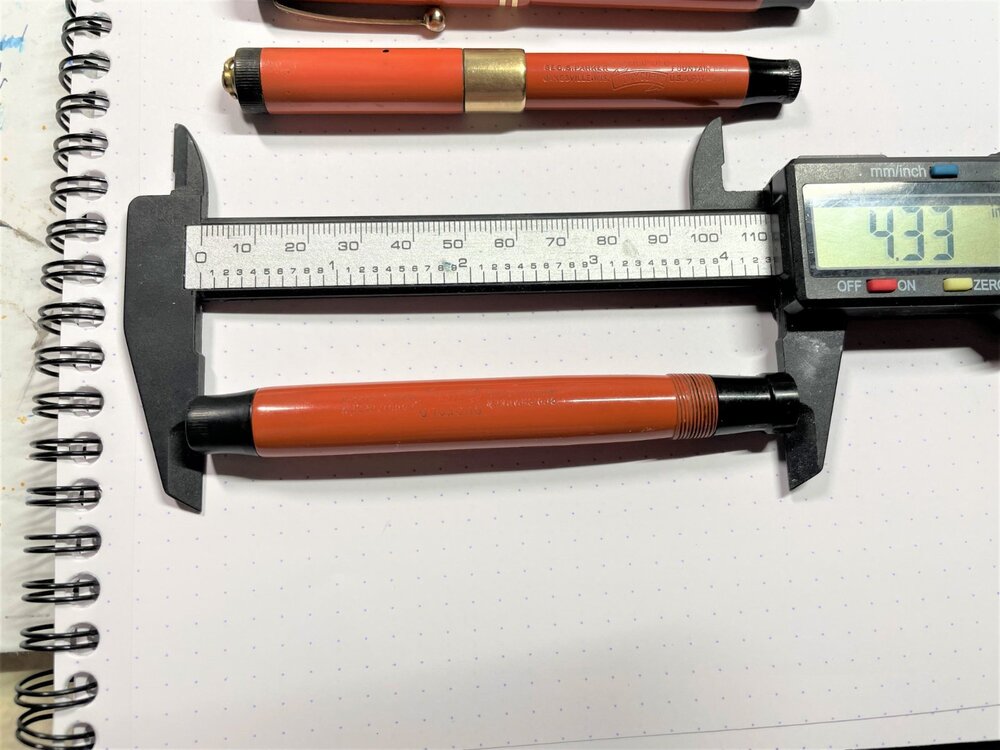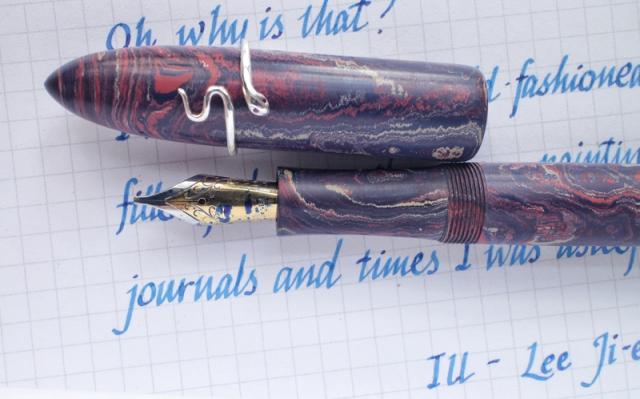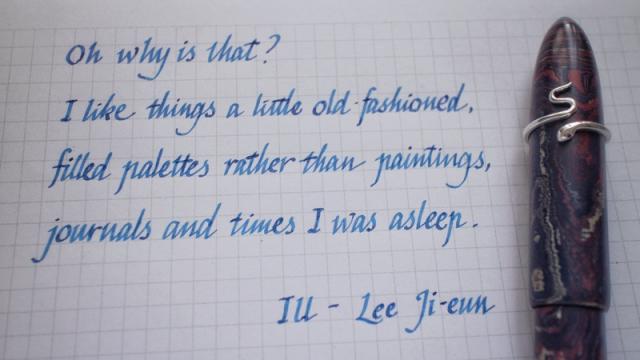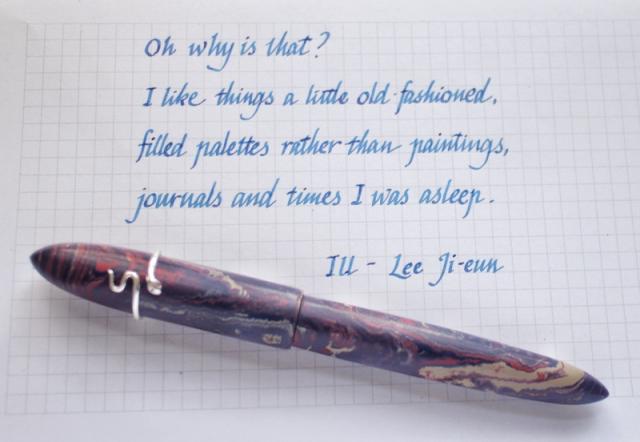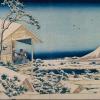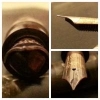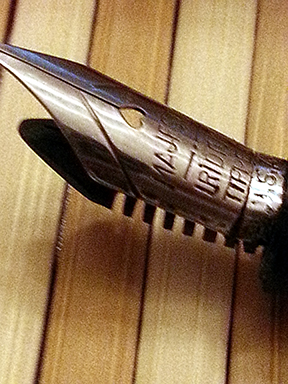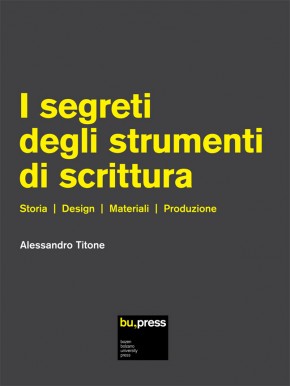Search the Community
Showing results for tags 'material'.
-
Hello pen experts: I recently acquired three Parker Duofolds. Two are identified as a Junior and a Lady. I am only showing the barrel and section on the third one as it did not come with a cap. Here are my questions: Is the imprint shown on each the medium imprint or the giant imprint? What is the approximate age of each? Are these pens hard rubber or permanite? I guess it depends on their age. I tried the rubbing and smell test, and it was inconclusive to me. Is the barrel shown from a Senior or a Special? It is .52 inches wide, and came with a Parker arrow nib, not shown which could have been a replacement. The feed was not ribbed. Thank you.
-
For five years, around 1980, I worked for a pen manufacturer, as designer and ingeneer. During this time I discovered that not everything that works, can be or needs to be explained. For an ingeneer, to accept magic and let it exist in his work is a huge step. Thirty odd years later, fountain pens still fascinate me, their function in particular. Therefore, I started publishing my memoires on my web site titled Fountain Pen Magic. You can / will find there all sorts of interesting things relating to technology, function and manufacture, as much as I can remember. The link to my site is https://fountainpendesign.wordpress.com/ Come and visit and let’s initiate communication amongst technically interested fountain pen lovers. At the moment, I write what I believe you are interested in. Writing can be a lonely task. Engagement with you will be a highlight. Enjoy reading and discovering Amadeus W. Penmacher Ingeneer PS: In case you wonder about my spelling of ingeneer… https://ingenioust.wordpress.com/about-ingeneering/engineer-ingeneer-spelling-etymology/
- 82 replies
-
- design methods
- design criteria
-
(and 5 more)
Tagged with:
-
Many words are translated by Google, but it is still easy to understand. I make a summary about the cost of various special materials that may be used in the pen making. Only special materials, such as TC4 titanium alloy/Brass/Normal Steel/Acrylic/Ebonite/ABS/Normal Plastic Carbon fiber and other conventional materials will not be discussed. All Materials Price is calculated with a ROD. Its size: φ15mm(Diameter)*150mm(Length) So the volume is 26507.1mm3≈26.5cm3 1---Non-precious metals (only the material cost itself is considered, and the processing cost is not calculated) 1.254SMO super stainless steel/654SMO super stainless steel 8 g/cm³ A kind of super austenite stainless steel, which has higher hardness and better corrosion resistance than 904L stainless steel. The material cost is about 50$ 212g. 2.DSN9 super stainless steel 8 g/cm³ A super austenite stainless steel with the highest hardness, it is better to perform nitriding treatment after forming. The material cost is about 70$119.25g. 3.TC21 titanium alloy 4.5 g/cm³ The hardness is softer than TC4, but the corrosion resistance is better. The cost of materials is about 40$ 120g. 4.Zirconium alloy 6.49 g/cm³ The hardness is high, the disadvantage is that the processing is more dangerous, and it is prone to spontaneous combustion. It is not recommended to consider the machine without professional treatment. 50-100$ 172g. 5.CoCrMo cobalt alloy 8.4 g/cm³ Dental alloys have very high hardness (see formula) and processing is slightly difficult. But the corrosion resistance is much higher than that of ordinary titanium alloys. The cost of materials is about 200-400$222.6g. 6.GH4169/Inconel718 nickel alloy 8.192 g/cm³ The nickel alloy with the best overall performance has good fatigue resistance, radiation resistance, oxidation resistance, corrosion resistance, as well as good processing performance and good welding performance. Able to manufacture various parts with complex shapes. The cost of materials is about 60$217.3g. NOTE:Some people are allergic to nickel. Be cautious! 7.TZM molybdenum super alloy 10.22 g/cm³ In essence, it is still a titanium alloy, but because the addition of molybdenum has better corrosion resistance, the hardness is slightly softer. The material cost is about 60$271.83g. 2---Plastic (only consider the cost of the material itself without calculating the processing cost) 1.PEEK 1.32 g/cm³ Polyetheretherketone, a kind of super engineering plastic. 30% carbon fiber reinforcement is the best. Good high temperature resistance, good rigidity and strength, suitable for engineering products with good chemical resistance such as machinery, electrical, automobile, chemical industry, etc. Of course, the unreinforced brown body is also a good choice. The material cost for making a pen is about 50$35g. 2.PEI 1.27 g/cm³ Polyetherimide, a kind of super engineering plastic. There is a very good overall performance without adding any fillers. Processing performance is better than acrylic, notch sensitivity is better than acrylic, weather resistance is higher than all current used pen plastics, the strength is similar to acrylic, the amber color is very beautiful, if stronger hardness is needed, carbon fiber can be used to enhance the cost. . The material cost to make a pen is around 20$33.65g. 3.PBI 1.3 g/cm³ Polybenzimidazole, a kind of super engineering plastic. Possess the highest mechanical properties among plastics. It has the best coefficient of thermal expansion and the highest compressive strength among all unreinforced plastics, making it difficult to process. Carbon fiber reinforcement can also be used. The material cost of making a pen is around 500$35g. 4.PPSU 1.29 g/cm³ Polyphenylsulfone, a kind of super engineering plastic. Highly corrosion resistant, can be repeatedly boiled at high temperature and steam sterilized. But the hardness is slightly softer. Carbon fiber can be used to enhance the hardness. The material cost of making a pen is about 50$34g. 5.PPS 1.35 g/cm³ Polyphenylene sulfide, a kind of super engineering plastic. Hard and brittle, high crystallinity, flame retardant, good thermal stability, and high mechanical strength. But the brittleness is greater than that of PBI, and the notch sensitivity is similar to acrylic. Try not to use threaded parts. The material cost of making a pen is around 10$35g. 6.PTFE 2.2 g/cm³ PTFE, the king of plastics. Because of its hardness is very soft but highly resistant to corrosion. It is only suitable for the sleeve of the pen tip assembly. The cost of ordinary casing is about 5$58.3g. 3---Ceramic glass (mostly consider mold cost) 1.Macor/Shapal M Soft/Ivoclar Glass Ceramic Machinable ceramics/Glass ceramics/Mica ceramics 2.5 g/cm³ All can be regarded as microcrystalline/mica machinable ceramics, meaning that they can be processed directly by CNC just like ordinary metals. The price depends on the formula. The material cost for making a pen is around 100-1000$ . 2.High temperature resistant quartz glass 2.65 g/cm³ Traditional materials, but threads can be processed. Fragile, but the transparency after processing is one of the best. The material cost for making a pen is about 40-400$. 3.Corning Gorilla Glass 2.40 g/cm³ Originally, I considered using Gorilla Glass, but its surface treatment greatly reduced the performance of the processed glass. This material only can be made into a box. 4.Alumina white (need mold) 3.72 g/cm³ Alumina ceramics require mold firing, which can be processed directly under special circumstances but the price is high. If it is mass-produced, the price of the each part can be spread down to 20$. But the cost of mold manufacturing is about 500$/part. You need to think about it before start. 5.Sapphire/Ruby 3.98 g/cm³ The same can be CNC, but it wastes tools and time. The processing cost is about 1000-3000$ for the price of a set. 6.Zirconia white/black (need mold) 5.68 g/cm³ The mold manufacturing cost is around 400$/part 7.Aluminum Nitride/Silicon Nitride (Mold required) 3.255 g/cm³ or 3.17 g/cm³ Top ceramics, with better performance. The mold manufacturing cost is about 800$/part. 8.Carbon carbon fiber ceramics 1.8 g/cm³ Known as CMC. Ceramics for racing brakes. Montblanc uses it in Montblanc StarWalker Ceramics Series. But only pen body is ceramic. If you want that full parts are CMC. The raw material is about 4000$/piece, and the processing cost is x2. 4---Precious metals Generally speaking, the precious metal pen body is very expensive and soft, which is not included in the discussion. If you must use the precious metal pen, it is recommended to customize the filling material. For example, changing the ratio of 75% gold to the remaining 25 can make the combined hardness exceed 300HV. At the same time, it still has appropriate toughness and can be machined. Of course, you can also find fountain pens customized for precious metals in jeweler or some bespoke service. The price is about 1000-3000$/piece. 5---Urushi-e/Maki-e 1.Urushi-e At first I did not like this paint because it is not weather-resistant and cannot be applied on the pen‘s inner tube. But then I found a solution. Adding 3-6% UV1130 and 2.5-5% UV292 in raw maki-e liquid can make it have amazing weather resistance. When painting, you can preprocess the rough reverse thread of wood/hard rubber/plastic, soak it in the raw lacquer solution, wait for it to dry in the incubator and repeat the above process. Then use the same 3-6% UV1130 and 2.5-6%UV292 resin AB glue to bond it with the threaded metal parts (titanium metal is recommended), which can greatly improve its durability. 2.Maki-e Many nano powder can also be used in Maki-E paintings. Nano alumina ceramic powder can provide pure white. Nano iron oxide can provide pure red. Cerium oxide is yellow. However, the safety of many powder materials is unknown. Nickel oxide presents a beautiful green color, but it is a toxic substance. So only use safe materials such as nano graphite, nano iron oxide and nano alumina ceramic particles. Or, the present silver gold powder is good enough. If you use powder, the weight of the powder depends on your design and theme. But in most common case, 10-20g nano powder is enough for you do draw a bird, a tree and a cat. The price of nano graphite iron oxide and alumina are also really cheap. 2-5$ That's my knowledge in special pen making materials. There may be some wrong because materials science is only my second major. If you see it you can help me to correct it. If you still have some special materials you can think of, just discuss it.
-
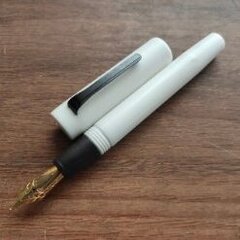
At least Shappire & Glass are not ideal materials for Pelikan M800
VonPG posted a topic in Fountain & Dip Pens - First Stop
This Pelikan Pen M800 is made of Optical Borosilicate Glass in body and Shappire in cap. However, after I made this pen within 48 hours it just broken(I am a very careful people who never drop a pen on the ground for 10 years) Maybe the only reason to explain it is that thread stroke was too long. At least I know that Shappire & Glass are too fragile to make a endurable fountain pen. So I remove those materials in my transparent pen making :{ Luckily, a friend made a optium museum acrylic pen body with sterling silver clip for me as “backup”. Some good transparent materials list in pen making PEI(Pure) Acrylic(Optium Museum Rate) Pasmo Special Amorphous Polymer Resin(Speical Polycarbonate and it is totally different from normal PC plasitc) Corning ULE Glass/SCHOTT Zerodur(Can be machined with diamond or other superhard tool knife) -
I recently acquired an Omas FOA Limited Edition pen. It seems to be in good shape, could us a tune of for sure, but there are a couple of things Id like to know before I keep the pen -On the barrel it says "OMAS EXTRA Italy". The other numbered versions I think only had "OMAS EXTRA" -I bought it without its standard box, even thought the seller sold me "box and papers" Fishy Overall it writes pretty well, piston is somewhat smooth. The nib looks legit but those other details seemed fishy.
-

Review Of Ranga Model 8B In Blue, Red And Pale Yellow Ebonite
bobje posted a topic in Fountain Pen Reviews
One of the great qualities of fountain pens is that they combine utility with beauty, in a tool we use daily. The material is a key factor in this formula, and a recent discussion on Fountain Pen Network gave people the chance to name the most beautiful materials they had ever seen. Italian celluloids topped the charts: Tibaldi Impero, Omas Arco, and Omas Burkina, for example. This month I began writing with a Ranga Model 8b pen made from a blue, red, and pale yellow ebonite recently created for the company, based in Thiruvallur in southern India. Its a gorgeous ebonite, layered in rich combinations of colors revealed only as the material is turned. The pens appearance is not so much polished as excavated, like an Italian building with a foundation built in Roman times, modified over multiple centuries, and then peeled back to reveal bits and pieces from ancient and gothic and baroque periods that combine in an elegant and irregular way. As a material, for me, this ebonite ranks in the Top 10. We can make a list: scarlet tanager from Parker and carmine from Sheaffer, in the United States; the three Italian celluloids above; ebonites from SEM in Hamburg and Nikko in Tokyo; just about anything from Mazzucchelli in Italy; and diffusion bonded acrylics from Carville in England. Thats pretty high cotton, as they said in the antebellum South. I do not know what company makes this ebonite for Ranga, but I suspect someone on FPN will tell us. Fountain pen people live for arcane details. [EDITORS NOTE: the Kandan family who operates Ranga Pens also makes its own ebonite, through the Loyal Ebonites company.) Beyond the material, the craftsmanship, finish, and threads on the pen are immaculate, and the proportions have been scaled up slightly from the Model 8. Its a form of sculpture for the hand, elegant and unpretentious, at prices more accessible than pens made from other Top 10 materials. This clipless model is filled with a cartridge-converter and contains a Jowo no. 6 nib, in an 1.1 mm italic. Ranga Pens offer a handmade quality that lends itself to roll-stoppers made from wrap rings. Snakes work well, and lotus flowers, turtles, dolphins, peacocks, and lizards. I inked the pen for the first time with Sailor Jentle Souten, a blue that shades nicely for a K-pop lyric by Lee Ji-eun. Pens write stories, and a pen from Ranga, created on a specific morning by people we can actually have conversations with, people with families and colds and shoes and favorite flavors of ice cream, offers its own human story. And in the meantime, between the work we are supposed to do and the letters we should have written, the snakes and peacocks and dolphins can keep us company. Capped, the Ranga Model 8b is 155 mm long; uncapped, 141mm; the section diameter is about 11 mm; barrel diameter is 14 mm; and cap diameter is 16 mm. I dont know how much it weighs, but its ebonite, so its light. -
Hello everyone, I saw this material a few months back on Fountain of Ink's Instagram. The pen itself was made by Herbus Casameerus. I wanted to know if anyone knew anything about the material it was made from? I have seen some close matches but nothing exact. Any information would be greatly appreciated! Thanks for looking.
-
Hi everyone, I am currently considering buying the Karas Kustoms Ink fountain pen. I am having trouble deciding on a nib material. I want a very rugged pen that I will be able to carry around without fear of breaking and so I also want a nib that will stand the test of time, i.e. resist to corrosion, not bend beyond repair too easily (although I am not much of a flex writer, I don't enjoy a stiff nib either) and generally be easy to maintain. The gold nib is out for me though just because I feel like it really doesn't fit wit the rest of the pen's design although if they ever came out with gold furniture gold would certainly be my main option. Or maybe you will convince me to pick gold despite the clip being silver coloured. I was wondering if I should just go with stainless steel or take a risk with titanium (even though Richard Binder seems to really strongly recommend against using titanium)? Thank you all very much in advance! Edited from the post I originally made. I must have a dreamt that they were offering platinum nibs...
-
Around 1980, I worked for a pen manufacturer, as designer and ingeneer, in Germany. During this time I got a good insight into the function of fountain pens and other pens and their manufacture. Thirty odd years later, fountain pens still fascinate me. I started a web site titled Fountain Pen Magic. You can / will find there all sorts of interesting things relating to technology, function and manufacture, as much as I can remember. The link to my site is https://fountainpend....wordpress.com/ I am happy to discuss any question you may have on those topics. Amadeus W. Penmacher Ingeneer PS: In case you wonder about my spelling of ingeneer… https://ingenioust.w...ling-etymology/
- 82 replies
-
- fountain pen
- research
-
(and 7 more)
Tagged with:
-
I am really interested in talking about materials of montblanc regular edition. I email official for many time, but some results really make me confused. http://www.montblanc.com/content/dam/mtb/products/writing-instruments/111/037/111037/191338-ecom-retina-01.png.adapt.500.500.png Montblanc STARWALKER EXTREME STEEL FOUNTAIN PEN its description lacks the material of pen's grip and clip , so I emailed the official website and got this reply:"The grip is made of steel, the clip is platinum plated. " However, it still lacks the vital part: plated what? brass or steel? After saw the second starwalker pen, the things made me more confused. http://www.montblanc.com/content/dam/mtb/products/writing-instruments/109/341/109341/191096-ecom-retina-01.png.adapt.500.500.png Montblanc StarWalker Carbon Fountain Pen Its description is "Platinum plated",so its grip can be made of platinum plated? These pens are exactly the same in grips! After I bought a very vintage pen 146, I knew that Montblanc Meisterstuck regular edition's metal is made of gold-plated brass, the same as Boheme regular edition. But, starwalker is totally different from those two series. I also go to the local montblanc store, the Clerk told me the clip is made of Germany nickel...after I bought Starwalker EXTREME STEEL FOUNTAIN PEN, I know the black part is rubber...But the item description seem to lose this introduction... Luckily, I got a official PDF about material, but the Johnny Lennon edition says the clip is stainless steel... So I just want to know which is the true inside material under the platinum-plated surface about starwalker carbon fountain pen's grip,clip and cap and extreme steel pen? Besides, Are starwalker all made of steel or just the extreme steel series? Of course I cannot use sandpaper to remove its cladding material to see inside material, it's really a waste.
-
Okay, so it's partly my own fault, but... ...two years ago at the Dallas Pen Show, I purchased this beautiful little Majestic vest pen? I call it a vest pen as it's small. I did not take reading glasses along with me at that time and my eye sight wasn't perfect. So, I took the pen on good fait that all was well. (Perhaps the seller's eye sight was as bad as mine!) Long story short, I went to clean/use the pen for the first time tonight (don't start with me as this is the third tiny pen I had acquired) and I decided to look and see if the nib had any flex. I started to gently press the nib on my nail and suddenly, I felt it give! I had barely even touched it to the nail at this point! Horror upon horrors, I got out the magnifying glass and looked. There was a definite break line across the base of the nib, right before the collar. Ugh!!! You can see it in the photo. It has since broken completely when I gently put it back down on the feed. I decided to clean the pen to see if the vue window would become clear and it pretty much has, but I noticed the underside of the original nib was quite corroded. I have read in the small amount of info I could find, that these nibs were just average at best. Thus I must ask...can replacement nibs be found? And, if not, what size nib would work as a replacement? The nib (unless I can get the tiny part still sticking out of the collar out) doesn't tell what the nib is made of. I'm guessing steal as the color is silver (with gold in the groves up front). Any help on this would be fabulous!! It would also make me feel better, lol! Here are some photos. It's a beautiful little pen!! (The clip is different than all the photos I've seen thus far, so no clue on age.)
- 30 replies
-
Dear friends it’s my pleasure announce you the out printing of my book, The Secrets of writing instruments - History, design, materials, production. A depth research on the topic of writing instruments, with a new and dynamic ways of reading with historical curiosities, information on the materials and methods of production, research supported with the laboratory analysis whose the methodology it’s explain to appendix . you can find it online and in the bookshop. http://bupress.unibz.it/it/i-segreti-degli-strumenti-di-scrittura.html faithfully A. Titone http://bupress.unibz.it/media/catalog/product/cache/2/small_image/290x/040ec09b1e35df139433887a97daa66f/i/m/image_101.jpg
- 2 replies
-
- bookwriting tools
- design
-
(and 7 more)
Tagged with:


